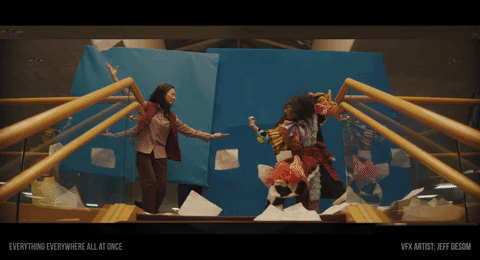An excerpt from the ‘Everything Everywhere All at Once’ article in issue #5 of befores & afters mag.
Issue #5 of befores & afters magazine is chock-full of invisible effects coverage, including about the VFX in director Daniel Kwan and Daniel Scheinert’s (‘Daniels’) Everything Everywhere All at Once.
Largely utilizing After Effects, a small team, led by visual effects supervisor Zak Stoltz, crafted scenes that ran the gamut from invisible effects to big effects shots. The idea was that these VFX would bed right in with the ‘crazy’ and frenetic style of the film and not call attention to themselves.

The magazine article is an interview with Stoltz–here’s an excerpt where he talks in particular about the bagel effects.
b&a: Since you mentioned the bagel, how did you all end up doing the effects work for it?
Zak Stoltz: Most of it was done in After Effects. I also got into Blender for the film, and I would do some particle effects there, just for the seeds. Ben did the main modeling and lighting for the bagel, but the way that a lot of that stuff was developed was, we would be passing projects back and forth and deciding, ‘What do we know how to do? Let’s push ourselves to our limits,’ while also recognizing that we were also not big ‘CG guys’. We didn’t have that experience, we didn’t want to look back and have this look like, ‘Oh, that’s the first time these guys had done CG.’ We really wanted to make sure that we weren’t going too far in that direction.
The bagel had a frontal element that we used for the bagel reveal. That was where it was just rotating around doing a full cycle. In fact, we didn’t even render it doing a full cycle. We just rendered it as long as the longest shot needed.

Everything else was 2D compositing over the top and involved making little lighting changes. We’d do things like make the interior of the bagel do this extra rotation in the same direction or the opposite direction–it makes it look like it’s twisting. That’s just something in After Effects done in a subtle way so that it doesn’t break the illusion of having all the lighting come in.
I took the bagel and found a random modifier that looked cool in Blender that literally just twisted the entire bagel a ton. Then I was like, ‘What if I made this go real fast?’ That seems like it could be cool and we just tested it out and just were like, ‘Oh, that’s really cool. Let’s just have that be the thing.’ A lot of it was just figuring it out as we went. It was a process of discovery.
b&a: It seems to suit the story because it’s a crazy moment and it is photorealistic, but, and I don’t mean this in a bad way, Zak, but it’s also nicely ‘unpolished’, if you know what I mean?
Zak Stoltz: Absolutely. That was also one of the goals from the beginning. When they came to me, the first thing I remember Daniel Scheinert saying, in terms of the way that they wanted it to look and feel, was less Marvel, more Ghostbusters. There’s a few different ways to interpret that. The less Marvel aspect of it was everything is starting to look the same in terms of, it’s perfect. It’s polished. It is the peak of what you can get in most cases, or it’s something that feels like, ‘That’s just the way you do it now.’

But the problem that I think a lot of us have, especially if you know visual effects, is that a lot of times you’re like, ‘That’s CG. That’s CG. That’s CG.’ You don’t get the same sense of satisfaction as if you’re seeing a crazy stunt and you’re just like, ‘Oh, shit. Did they just do that? They really just did that! I want to see the behind the scenes.’ Instead, it’s just like, ‘Oh, yeah. It was just an animated character.’
We wanted to make sure that everything stayed very grounded and, going back to the Ghostbusters thing, they didn’t have the technology to do everything in CG then. Everything was photographed at some point before being composited in. That’s something that we’ve always done, partially out of necessity, because we all just came up learning After Effects on YouTube and on Video Copilot and just figuring it out because we needed to figure out how to do something for one of our projects that we were making. None of us are formally trained in any visual effects software or anything. It’s just that we just started doing it and it became a part of our filmmaking process.

We wanted to keep everything really grounded in a practical base because we knew that we couldn’t make it look as good as ILM, and we had five people doing most of the effects. We couldn’t wait for all the render times. It had to be a very responsive process. Everything was just in After Effects, a practical base, add some stuff over the top, make it a little bit dirty just so that it would feel not only on-brand for them as directors, but also that it would work with the story.
I think that it is something where, even though the realities get really crazy in the film, they all feel real. I think that’s why people respond to the film because everything feels real. There’s still a dramatic through-line that you can hold. We keep it grounded so that it still feels as much in that world as possible.


















